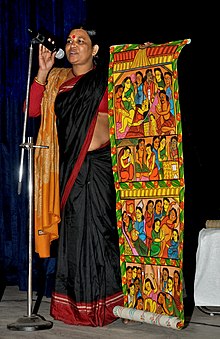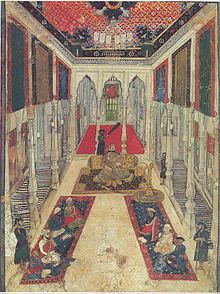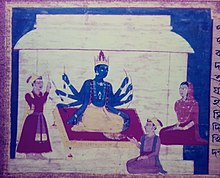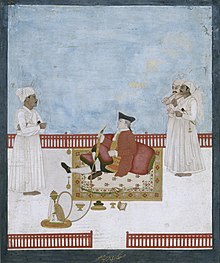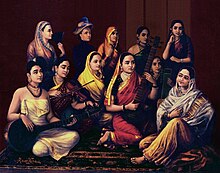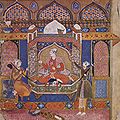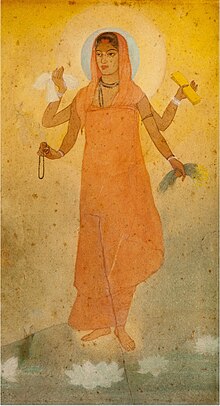
A miniature is a small illustration used to decorate an ancient or medieval illuminated manuscript; the simple illustrations of the early codices having been miniated or delineated with that pigment. The generally small scale of such medieval pictures has led to etymological confusion with minuteness and to its application to small paintings, especially portrait miniatures, which did however grow from the same tradition and at least initially used similar techniques.

The Salar Jung Museum is an art museum located at Dar-ul-Shifa, on the southern bank of the Musi River in the city of Hyderabad, Telangana, India. It is one of the notable National Museums of India. Originally a private art collection of the Salar Jung family, it was endowed to the nation after the death of Salar Jung III. It was inaugurated on 16 December 1951.

Indian art consists of a variety of art forms, including painting, sculpture, pottery, and textile arts such as woven silk. Geographically, it spans the entire Indian subcontinent, including what is now India, Pakistan, Bangladesh, Sri Lanka, Nepal, Bhutan, and at times eastern Afghanistan. A strong sense of design is characteristic of Indian art and can be observed in its modern and traditional forms.

The Bengal School of Art, commonly referred as Bengal School, was an art movement and a style of Indian painting that originated in Bengal, primarily Kolkata and Shantiniketan, and flourished throughout the Indian subcontinent, during the British Raj in the early 20th century. Also known as 'Indian style of painting' in its early days, it was associated with Indian nationalism (swadeshi) and led by Abanindranath Tagore (1871–1951), but was also being promoted and supported by British arts administrators like E. B. Havell, the principal of the Government College of Art and Craft, Kolkata from 1896; eventually it led to the development of the modern Indian painting.
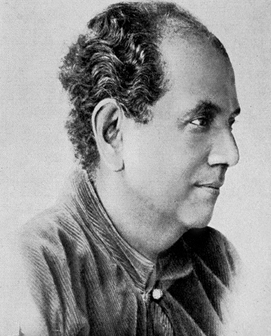
Abanindranath Tagore was the principal artist and creator of the "Indian Society of Oriental Art". He was also the first major exponent of Swadeshi values in Indian art. He founded the influential Bengal school of art, which led to the development of modern Indian painting. He was also a noted writer, particularly for children. Popularly known as 'Aban Thakur', his books Rajkahini, Buro Angla, Nalak, and Khirer Putul were landmarks in Bengali language children's literature and art.

Mughal painting is a South Asian style of painting on paper confined to miniatures either as book illustrations or as single works to be kept in albums (muraqqa), originating from the territory of the Mughal Empire in the Indian subcontinent. It emerged from Persian miniature painting and developed in the court of the Mughal Empire of the 16th to 18th centuries. Battles, legendary stories, hunting scenes, wildlife, royal life, mythology, as well as other subjects have all been frequently depicted in paintings.

Nandalal Bose was one of the pioneers of modern Indian art and a key figure of Contextual Modernism.
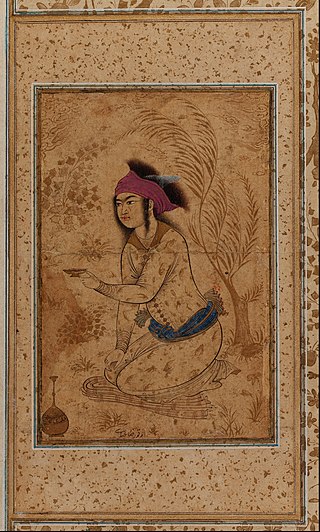
A Muraqqa is an album in book form containing Islamic miniature paintings and specimens of Islamic calligraphy, normally from several different sources, and perhaps other matter. The album was popular among collectors in the Islamic world, and by the later 16th century became the predominant format for miniature painting in the Persian Safavid, Mughal and Ottoman empires, greatly affecting the direction taken by the painting traditions of the Persian miniature, Ottoman miniature and Mughal miniature. The album largely replaced the full-scale illustrated manuscript of classics of Persian poetry, which had been the typical vehicle for the finest miniature painters up to that time. The great cost and delay of commissioning a top-quality example of such a work essentially restricted them to the ruler and a handful of other great figures, who usually had to maintain a whole workshop of calligraphers, artists and other craftsmen, with a librarian to manage the whole process.

Government Museum and Art Gallery, Chandigarh, is a premier museum of North India having collections of Gandharan sculptures, sculptures from ancient and medieval India, Pahari and Rajasthani miniature paintings. It owes its existence to the partition of India in August, 1947. Prior to the partition, much of the collections of art objects, paintings and sculptures present here were housed in the Central Museum, Lahore, the then capital of Punjab. The museum has one of the largest collection of Gandharan artefacts in the world.

Painting is a visual art, which is characterized by the practice of applying paint, pigment, color or other medium to a solid surface. The medium is commonly applied to the base with a brush, but other implements, such as knives, sponges, and airbrushes, can be used.

Tribal art is the visual arts and material culture of indigenous peoples. Also known as non-Western art or ethnographic art, or, controversially, primitive art, tribal arts have historically been collected by Western anthropologists, private collectors, and museums, particularly ethnographic and natural history museums. The term "primitive" is criticized as being Eurocentric and pejorative.

Patachitra or Pattachitra is a general term for traditional, cloth-based scroll painting, based in the eastern Indian states of Odisha, West Bengal and parts of Bangladesh. Patachitra artform is known for its intricate details as well as mythological narratives and folktales inscribed in it. Pattachitra is one of the ancient artworks of Odisha, originally created for ritual use and as souvenirs for pilgrims to Puri, as well as other temples in Odisha. Patachitras are a component of an ancient Bengali narrative art, originally serving as a visual device during the performance of a song.
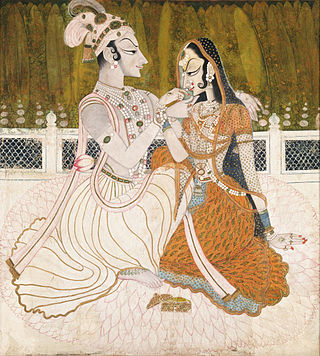
Apart from the architecture of Rajasthan, the most notable forms of the visual art of Rajasthan are architectural sculpture on Hindu and Jain temples in the medieval era, in painting illustrations to religious texts, beginning in the late medieval period, and post-Mughal miniature painting in the Early Modern period, where various different court schools developed, together known as Rajput painting. In both cases, Rajasthani art had many similarities to that of the neighbouring region of Gujarat, the two forming most of the region of "Western India", where artistic styles often developed together.

The modern Indian art movement in Indian painting is considered to have begun in Calcutta in the late nineteenth century. The old traditions of painting had more or less died out in Bengal and new schools of art were started by the British. Initially, protagonists of Indian art such as Raja Ravi Varma drew on Western traditions and techniques including oil paint and easel painting. A reaction to the Western influence led to a revival in primitivism, called as the Bengal school of art, which drew from the rich cultural heritage of India. It was succeeded by the Santiniketan school, led by Rabindranath Tagore's harking back to idyllic rural folk and rural life. Despite its country-wide influence in the early years, the importance of the school declined by the 'forties' and now it is as good as dead.

Raman Siva Kumar, known as R. Siva Kumar, is an Indian contemporary art historian, art critic, and curator. His major research has been in the area of early Indian modernism with special focus on the Santiniketan School. He has written several important books, lectured widely on modern Indian art and contributed articles to prestigious international projects such as the Art Journal, Grove Art Online or The Dictionary of Art, Oxford University Press.

Deccan painting or Deccani painting is the form of Indian miniature painting produced in the Deccan region of Central India, in the various Muslim capitals of the Deccan sultanates that emerged from the break-up of the Bahmani Sultanate by 1520. These were Bijapur, Golkonda, Ahmadnagar, Bidar, and Berar. The main period was between the late 16th century and the mid-17th, with something of a revival in the mid-18th century, by then centred on Hyderabad.

The Indian state, West Bengal has a rich cultural heritage. Due to the reign of many different rulers in the past, arts and crafts in West Bengal underwent many changes giving an artistic diversity today in the forms of traditional handicrafts, terracotta, painting and carving, dances and music.
Bihar is a state in eastern India divided by the Ganges river, an area which was once an important center for culture and learning. A Neolithic settlement has been discovered at Chirand which contains rock paintings similar to those found in Spain's Altamira and France's Lascaux regions. The tradition of painting has been handed down from generation to generation in the families of the Mithila and Bhojpur regions mainly by women. Painting was usually done on walls during festivals, religious events, and other milestones of the life cycle, like birth, Upanayanam, and marriage. Other styles of this region include Tikuli, Manjusha, and Patna kalam.

Chitra or citra is an Indian genre of art that includes painting, sketch and any art form of delineation. The earliest mention of the term Chitra in the context of painting or picture is found in some of the ancient Sanskrit texts of Hinduism and Pali texts of Buddhism.
Indian miniature paintings are a class of paintings originating from India. Made on canvases a few inches in length and width, the Indian miniatures are noted for the amount of details that the artist encapsulates within the minute canvas frame; and the characteristic sensitivity with which the human, divine and natural forms are portrayed. They depict a variety of topics such as legends and myths, human passions and pains, aspirations, and physicality. From their origins in cave paintings, to the later Mughal and Pahari schools, the Indian miniatures represent a diversity of styles and themes, varying between the religious and the secular. Today most of these forms have perished, and are no longer practiced, due to the decline in royal patronage, and subsequent changes in the country's socio-cultural scenes. However, several of these canvases today survive in museums and private collections, defining India, her lifestyle and the aesthetic idiom of her past, as well as the essence of her soil, her creative imagination, colours, and thought.

